Daniel M. Russell's Blog, page 27
May 19, 2021
Answer: How to do slow research?
Searching slowly isn't the norm...
 1.5 million balloons over Cleveland
1.5 million balloons over Cleveland
In fact, people search engine companies go to a lot of trouble to make sure that searches return results as quickly as possible. We know (see this paper, for instance) that even a little delay (0.1 seconds) will cause a fall-off in user response!
But we know that not all SRS Challenges require instant responses. Sometimes slow and deliberate is the way you want to go--especially with complex topics that require some depth. Let's call this kind of search slow research. What are some ways to do this?
I put this to you with this specific idea--Suppose I want to write a book on this topic:
Sometimes when you take an action, something very unforeseen happens as a consequence after that action is taken.
For example: in 1986, the Cleveland United Way charity planned on releasing 2 million balloons as kind of spectacle, with donors pitching in to sponsor a balloon. But with a storm coming into the city, they decided to release the balloons early, causing all kinds of problems with the flood of balloons in the area, ultimately causing a net loss for the charity along with a host of problems.
What a fascinating topic! But how can I make this long-lasting research problem work well?
With this as context, the Challenge for last week was...
1. How would you set up a continuing stream of information to you about this topic? This is partly a question about the way to do this, but also a question about what the search terms should be. What would you do? How would you search for this phenomenon?
Let's break this Challenge up into two parts:
A. What would be good search terms for this potential book topic? (That is, what would you search for?)
B. How can we set up a continuous stream of information that will bring information about this topic to me?
A: The question for part A is the eternal quest for great search terms and phrases. Our Challenge task is a fairly complex / subtle topic. The first sentence in the Challenge is "..Sometimes when you take an action, something very unforeseen happens as a consequence after that action is taken..." Let's work forward from what we have towards some terms and phrases that might be useful.
Here, the key ideas are:
a. taking an action that has an outcome,
b. that outcome isn't what is expected,
c. that outcome isn't desirable.
What's a succinct way to describe this?
Here I'm looking for a stereotypical phrase, something that people would write about--something that captures the sense of this idea.
I started with a query:
[ action with unexpected outcome ]
Note that I'm NOT looking for a result, I want to scan the texts of these results looking for a common phrase that would capture the essence of this idea.
Here's what I see in my SERP. Note the two phrases I've circled...

"Unintended consequences" is a good phrase that is pretty much what I want to find.
How else could I find other phrases for searching?
One quick way is to look at the suggestions Google gives as you type your search. Here's what I saw:

This more-or-less confirms that the phrase unintended consequences is pretty good, but it also suggests "intended action"... which makes me think that perhaps searching for the opposite idea ("unintended benefits"!) might be a good idea.
Let's keep pushing on the unintended consequences idea for a moment. I could do a search for:
[ "unintended consequences" synonym ]
Which gives more good ideas:

Of course, exploring the other results (by opening in other tabs--for lateral browsing) leads to some interesting findings. Additional useful phrases I found like this are collateral consequence, blowback, boomerang, side effects, adverse reactions.
One more idea: I also want to check out what a reverse dictionary might tell me. (Remember we've talked about this idea before.) You just do a search for [ reverse dictionary ] and enter "unintended consequences" and...
[image error] From the OneLook dictionary/thesaurus
There are some great suggestions here: blowback, accident, serendipity, law of effect, etc.
You get the idea. Working from the fairly pedestrian, ordinary description of the Challenge, we can get to some useful search terms. In this case, we went from a fairly open-ended and ambiguous statement to search terms that are reasonably precise.
Now... what about Part B?
B: As we know, many search tasks are NOT quick short-fact lookups. If you're buying anything fairly expensive (think: car, refrigerator, vacation), you probably do more than one or two searches, and probably over a long period of time. You probably look things up, extract some information, and then consolidate that info to make a decision later.
Likewise, if you're researching any complex topic (such as a medical issue that you or someone in your family has), then you've started a legit longitudinal research process. Such research tasks often need some way to keep the task front-and-center. People often start a longitudinal research process with the best of intentions, but then drop it somewhere along the way. Obviously, that doesn't happen with high priority research tasks (like learning about and managing a critical health care problem), but for the other tasks--in my case, writing a book on this topic--we need to set up periodic reminders to pay attention to the task.
The two tricks I use to help me stay focused are:
1. Set up a repeating calendar appointment with yourself. I check my Calendar multiple times each day ("what am I supposed to be doing now??"), so it's part of my work practice. To keep moving forward on book writing, I just set up a 2-hour meeting with myself on the Calendar for 2 days out of the week. (When the writing gets more focused, I'll change it to be 1 hour/day.)
That's a simple hack.
2. Use Google Alerts to keep a constant stream of new results coming to you in email. This not only keeps reminding you that you're working on this topic, but it also keeps you abreast of the latest developments.
It's easy to set up an Alert. I just do a search for the link: [ Google Alerts ] -- that will bring the link to the Alerts setup page for you. Once there, it's straightforward to set up a repeating search (using all of the Google search tricks you know about). I set mine up to run daily, showing me the "best results" for all of the different media streams.
Then, my email inbox gets a stream (once/day) of relevant articles. Looks like this:

You can see that my Alert query is: ["unintended consequences" OR "unintended side effect" OR "unintended effect"]
Bonus Alert Hack: It turns out that Google Scholar has its own Alert system. (That is, you can't set up the regular Google Alert to also search through Scholarly results--you have to set up your Alerts over there.) Use the same trick of searching for the link: [ Google Scholar Alerts ] to take you to the Scholar Alert setup page.
[image error]I could have put in a longer query here ("unexpected consequences" OR "unintended consequences" OR "blowback") but I wanted to keep the example simple.
Search Research Lessons
1. Sometimes slow search is the way to go. Complex topics often require real research work on your part. Learn to recognize tasks like this and learn to NOT blow through the questions as quickly as possible. I'm sorry to tell you, but research sometimes requires work! Embrace this.
2. Setting up calendar reminders to work on a research task work quite well. This is especially true if you run your life off your online calendar.
3. Use the Google Alerts to get automatic updates of new information. You can use all of the power of Google search and have them emailed to you daily.
4. For more academic or scholarly research questions, remember to use Google Scholar Alerts! They're NOT automatically included in your default Alerts.
5. You can search for synonymous phrases by regular search. It's worth spending a few extra moments to search for a better way to phrase your query--one that captures your intent more precisely.
Hope this was useful to you. Search on!
May 12, 2021
SearchResearch Challenge (5/12/21): How to do slow research?
Suppose...
 1.5 million balloons over Cleveland
1.5 million balloons over Cleveland
... that you want to write a book about something that you only partly understand but find fascinating. Obviously, you want to spend some time coming up to speed, perhaps learning about the area over the next year or so.
How would you do that?
What would you actually do to become an autodidact (that is, a self-taught person) in that topic? While there are many things one could do (take an online class, read a lot of books, subscribe to blogs and vlogs)... is there some way to get information on this topic in a regular way? Some way to skim off the latest writings on your topic and get a constant feed of information?
Let's call this slow research. In many ways, this is the opposite of the quick Google search; it's not the same as just finding the factoid you want as rapidly as possible.
Instead, this is research over time, letting deeper understanding of a topic emerge, develop, and grow into something rich and marvelous.
The question for us is how do you do this?
There are many ways to answer this, but let's frame this as an SRS Challenge:
Suppose I want to write a book on this topic:
Sometimes when you take an action, something very unforeseen happens as a consequence after that action is taken.
For example: in 1986, the Cleveland United Way charity planned on releasing 2 million balloons as kind of spectacle, with donors pitching in to sponsor a balloon. But with a storm coming into the city, they decided to release the balloons early, causing all kinds of problems with the flood of balloons in the area, ultimately causing a net loss for the charity along with a host of problems.
Note that the topic is NOT "balloons" or "charity" or "disasters," but it's about the effect of making one decision (the early release of balloons) and the after-effects that followed from that bad choice.
And so the Challenge for this week is...
1. How would you set up a continuing stream of information to you about this topic? This is partly a question about the way to do this, but also a question about what the search terms should be. What would you do? How would you search for this phenomenon?
Suggestions welcome (I really AM writing a book on this topic, and I'm curious what good advice you'd give to said author).
Search on!
May 5, 2021
Answer: Internal incorporation?
Know how some animals use tools?
 P/C Cyberminnie at Flickr
P/C Cyberminnie at FlickrIn our last episode we saw this pom pom crab as it carries a sea anemone in each of its claws, using them as a defensive tool in the crab-eat-crab world on the coral reef. The anemones are essential external tools that are other living organisms.
But looking at the pom pom crab (and other animals that use other animals) makes me wonder about the nature of animals that incorporate (that is, literally in-corporate, take another organism into their body). There are certainly many parasitic organisms, including obligate parasites that can only live on a specific kind of host. But...
1. Can you find another invertebrate that incorporates PART of another animal into its body? That is, one animal doesn't take the whole, but just select parts, and incorporates those parts into its own body?
I started with a simple search:
[ what animals incorporate other animals ]
That led me to reading about how some animals incorporate genes from other animals. Humans, for example, have incorporated over 100 genes from other animals during the course of their evolution. (Science journal "Humans may harbor more than 100 genes from other animals.")
And THAT article reminded me about how human cells incorporated mitochondria (the organelles that are responsible for energy production in cells). They seem to have been independent bacteria that became incorporated into eukaryotic cells about 7 billion years ago.
When this happened, the previously independent pre-mitochondria bacteria became an endosymbiont -- that is, any organism that lives within the body or cells of another organism.
Next query:
[ how did mitochondria evolve ]
led me to learn about the organism Elysia chlorotica which has green chloroplasts in its body as endosymbionts.
 Elysia chlorata--the photosythesizing sea slug. (Head end on the right side.)
Elysia chlorata--the photosythesizing sea slug. (Head end on the right side.)
Okay then, to learn about Elysia...
[ Elysia chlorotica ]
led me to the Wikipedia article, which told me that E. choloratica incorporates chloroplasts into its body from its food. That is, the chloroplasts (the green organelles that are responsible for photosynthesis) found inside of the sea slug aren't made by the slug, but are incorporated into its body after eating its food source, the algae Vaucheria litorea, which actually makes chloroplasts.
2. Is there a specific term for this? (As you know, if you know the special term, that makes searching much, much simpler and more accurate.)
In reading during the search process, I came across two terms that are useful in this search. Endosymbiont (which we saw above), and another term, kleptoplasty, which is when one organism steals part of another animal!
Searching for:
[ kleptoplasty ]
Which leads to the Wikipedia article about kleptoplasty. Not a surprise. But when I poked around a bit in the article, I found another sea slug, Pteraeolidia ianthina, incorporates chloroplasts, but additionally incorporates nematocysts from other food sources. Oddly, it's barely a footnote in the article, but if you search for:
[ nematocysts sea slugs ]
it leads to a number of articles (e.g., Smithsonian) that teach us that some sea slugs (such as aeolid sea slugs) not only consume the nematocysts, but then incorporate them into their bodies. Surprisingly, when aeolids feed food sources with nematocysts (such as hydroids), the first thing they do is prevent the stinging cells from firing by using the mucus lining of their gut. These nematocysts originate in the cnidarians (such as sea anemones, hydroids, jellyfish, corals, siphonophores, etc.) that are the food source for aeolid nudibranchs. Once eaten, the unfired nematocysts pass through the slug's digestive tract, but some are excreted with the rest of the nudibranch's waste, but immature stinging nematocysts are stored in pouches called cnidosacs until they have matured and are needed.
These slugs (also called nudibranchs) will then fire the stolen stinging cells when threatened, with the nematocysts stinging anything that tries to eat the nudibranch. The nematocysts are stored in protruding cerata (those spine-looking things) on their backs. And at the tip of each branch of the cerata, the nematocysts are stored in a small sac, the cnidosac.
Here are a couple of spectacular photos of aeolid nudibranchs taken by friend Randall Spangler.
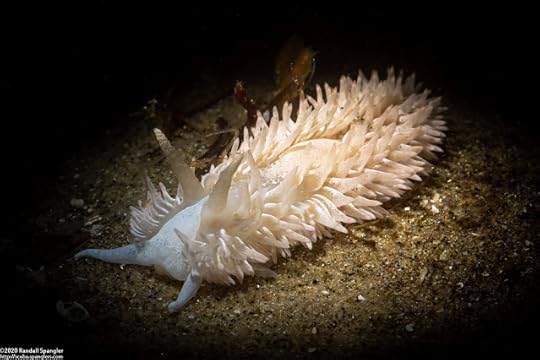 The cerata on the back of this Aeolidia papillosa end with cnidosacs. Like Elysia, they incorporate dinoflagellates that provides some photosynthesis capability. P/C Randall Spangler.
The cerata on the back of this Aeolidia papillosa end with cnidosacs. Like Elysia, they incorporate dinoflagellates that provides some photosynthesis capability. P/C Randall Spangler.  The Flabellina iodinea (Spanish Shawl) nudibranch is spectacular, but the nematocysts are an effective defense mechanism that has been co-opted from its food sources, primarily hydroids and anemones. P/C Randall Spangler.
The Flabellina iodinea (Spanish Shawl) nudibranch is spectacular, but the nematocysts are an effective defense mechanism that has been co-opted from its food sources, primarily hydroids and anemones. P/C Randall Spangler.Searching for kleptoplasty in Google Books teaches us to distinguish between kleptocnidae (cnidae taken from cnidarian prey and used for the consumer’s defense) and kleptoplasty (chloroplasts or whole photosynthetic cells that continue photosynthesizing after ingestion by herbivores, mostly sacoglassans, the photosynthetic nudibranchs).
Search Lessons
1. Learn as you go. The striking thing about this Challenge was that it took a bit of reading to get to the technical terms (e.g., endosymbiont, and kleptoplasty) and the concepts behind them.
I started with a generic search: [ what animals incorporate other animals ] which led to learning about gene acquisition, and that led to searches for how mitochondria came to be incorporated, leading to the query [ how did mitochondria evolve ] which led to our discovery of how chloroplasts and nematocysts came to be part of nudibranch bodies.
This is a great example of learning as you search, picking up terms and concepts that you don't about ahead of time, but acquire as you work through the searches.
In a sense, as you search, you're performing your own kleptoplasty of ideas, incorporating what you've learned into your personal knowledge base.
I have to admit, these are the kinds of SearchResearch Challenges I like the best--they require some real learning and discovery along the way. Hope you enjoy them as well!
Search on!
April 21, 2021
SearchResearch Challenge (4/21/21): Internal incorporation?
Know how some animals use tools?
 P/C Cyberminnie at Flickr
P/C Cyberminnie at FlickrThis pom pom crab carries a sea anemone in each of its claws, using them as a defensive tool in the crab-eat-crab world on the coral reef. The anemone has a great relationship with the crab, but it's completely external--it never becomes part of the crab.
But, as you know, some animals take this to an extreme. Corals are actually two different animals--the invertebrate that looks like a small anemone plus a particular kind of zooxanthellae (a single-celled dinoflagellate) that lives symbiotically in its tissues. The coral animal can get the dinoflagellate from its parent (the eggs pick up the zooxanthellae before being spawned), or they can pick them up from the environment by ingesting dinoflagellates that happen to be passing by the coral.
 P/C Dan. White soft coral in the Somosomo Strait, Fiji.
P/C Dan. White soft coral in the Somosomo Strait, Fiji.
Likewise, lichen are a composite organism made up of one (or more) algae, fungi, and often a kind of yeast. Lichen mostly reproduce by breaking apart--each little piece then grows into a larger, complete organism. But lichens can reproduce sexually, in which case the fungal spores must meet with a compatible algal partner before a complete and functional lichen can form.
 Orange crustose lichen on a rock in southern Silicon Valley. P/C Dan.
Orange crustose lichen on a rock in southern Silicon Valley. P/C Dan.
Seeing these examples makes me wonder about the nature of animals that incorporate (that is, literally in-corporate, take another organism into their body). There are certainly many parasitic organisms, including obligate parasites that can only live on a specific kind of host. But...
1. Can you find another invertebrate that incorporates PART of another animal into its body? That is, one animal doesn't take the whole, but just select parts, and incorporates those parts into its own body?
2. Is there a specific term for this? (As you know, if you know the special term, that makes searching much, much simpler and more accurate.)
This might not be the simplest Challenge, but it's certainly a fascinating topic. I know of at least two invertebrates that can do this incorporation of parts: Can you find others?
Let us know how you found your answers!
Search on!
April 14, 2021
Answer: Can you find the original source of this picture?
It's not every day you look for swordfights...

And yet, that's what this week's Challenge is all about: What's the story with this image that I found in a well-known magazine?
1. What is this an image of? (What's going on here?)
I'm no fool--I'll first try right-clicking on the image (Control+click on a Mac) to Search Google for Image.
Unfortunately, Google's Search-By-Image doesn't find any other versions of this image; neither does Yandex or Bing.
Next image search engine? I tried Tineye.com next for the search, and found it easily.
 Search results from TinEye.com
Search results from TinEye.comThese results found a version in the Adobe stock photos, eBay, and multiple hits at the Economist.com website (which is where I first saw it, in an article in the print edition). The Economist's version of the illustration is a high-quality version, but it's clearly cropped from the original.
How do we figure out what's happening in the image?
I opened the first hit (a link to stock.adobe.com) and found that the descriptor for the image is "A German student's duel at Gottingen. The Mensur, as practised by German fraternities, is a fast yet rarely-lethal affair with cuts accepted as marks of honour."
That's a great clue about what to search for next:
[ mensur ]
this leads to the Wikipedia article about Mensur, which tells us that it's a German dueling tradition--the duels among students that often lead to dueling scars, a "smite" (German Schmiss), seen as a badge of honor, in the second half of the 19th century and the first half of the 20th. This is a non-lethal duel, with the eyes protected by iron spectacles, made of strong wire net instead of glass. Cuts to the head are accepted as part of the calling of honor, which is why we have the classic image of a German military officer (of a certain age) showing dueling scars.
2. Where and when did this image first appear?
I know the image is a cropped version of some earlier publication, the question is--how do I find the full illustration? I hope it was published in some journal. If I can find the full illustration in situ, then maybe I can find the publication.
One of the interesting hits in the Tineye results page was to eBay.it (the Italian eBay). Turns out there are LOTS of mensur images there. And that made me wonder if some there were some for sale on the US eBay. Tried:
[ a student german duel in gottingen ]
and--what do you know!--I found this image, exactly what I was looking for:

The seller is counting on someone wanting a single page of an archival newspaper. This worked out well for my search because if you look at the full image,
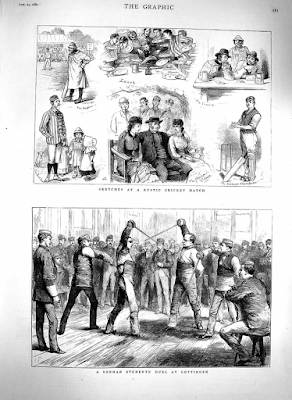
you'll see at the very top of the page:

Where it clearly (although in tiny font size) says that this illustration is from "The Graphic," page 181, publication date of Aug 21, 1880. ("The Graphic" was a British weekly illustrated newspaper, first published on 4 December 1869 and ran until April 1932 when it changed title to "The National Graphic," running between April and July 1932, when it ceased publication, after 3,266 issues.)
3. Can you find an online version of the original publication?
My search was straightforward:
[ "the Graphic" newspaper archive ]
which leads to a number of different archival resources. I spotted Newspapers.com among them, so I went there first.
(Why? Because I know this site typically has excellent scans of their documents, along with a great search tool and viewer. It's just a great resource. It DOES require a subscription, which I happily pay each year. You might be able to access it through your local library, as they very well might have a subscription that you can use.)
On the Newspapers.com site I selected "The Graphic: An Illustrated Weekly Newspaper" and then searched for "a german student duel" -- that gave me the one hit I was looking for: Page 181, publication date of Aug 21, 1880.
 Closeup of the mensur duelists (from the Newspapers.com scan)
Closeup of the mensur duelists (from the Newspapers.com scan)
Search Lessons
1. There are multiple search-by-image engines out there: Use them all! I tried Google, then Yandex, then Bing, then Tineye. They're all great, but they also all gave very different results. This is partly due to algorithmic differences, but also partly due to differences in the pages they crawl. If they don't have it in their data, they can't serve the result to you. Use all of them!
2. Pick up partial clues from what you DO find. I found the word "mensur," which I'd never heard before, as a description of this image. That's a mighty handy word to know if you're trying to understand what's going on here. Knowing that single word then led me to a full-page image, which gave me the date and the name of the publication.
3. Don't underestimate the value of eBay and other for-sale sites. I've found more useful clues for historic information in for-sale images than you can imagine. While I might not purchase the item for-sale, the image posted is incredibly useful for getting additional context and more search terms. That's how I figured out that this illustration came from "The Graphic," and what the date of the image was. Handy!
Congrats to all of the SRS searchers who found the answers.
Search on!
April 7, 2021
SearchResearch Challenge (4/7/21): Can you find the original source of this picture?
The other day...
... I was reading a well-known magazine / newspaper when I saw this remarkably graphic image that ran as part of the story:

I was struck by the image--What is going on here?--and by the lack of attribution. This led me to this week's Challenge. Can you figure this one out?
1. What is this an image of? (What's going on here?)
2. Where and when did this image first appear?
3. Can you find an online version of the original publication?
As always, tell us HOW you found the answers.
(This took me about 25 minutes. Can you do it in less time?)
Search on!
March 31, 2021
Answer: What ARE those things?
I often look at the world and wonder...
 Gratuitous curious internet cat image, although she's probably
Gratuitous curious internet cat image, although she's probablywondering why you haven't delivered her next meal yet...
... what is that thing I'm looking at? This happens to be a cat, but what about more difficult questions?
This happens all the time. I usually take a photo and then SearchResearch it when I get home.
Here are three images I posted last week. How well did you do?
1. What's going on here? Or, more properly, what happened here? This seems a bit... unusual, no?
 Link
LinkThe first trick for many such Challenges is to look carefully at the image. What ELSE do you see? In this case, you can immediately spot that the telephone pole is pretty badly burned. That's definitely interesting. If you ALSO notice that there's another telephone pole in the background. I zoomed in on that and saw this in closeup:
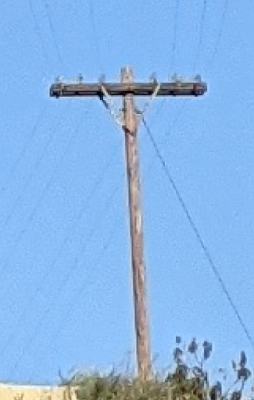
We're clearly starting to see pixels here, so this is about the max resolution I can get out of the image. I note that there are 6 insulators on top of the crossbar. If you zoom into the objects dangling above the burned telephone pole, you can see this:
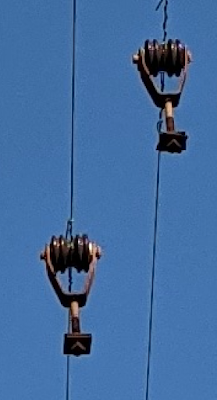
The angle looks a little funny, but these look like the same insulators as we see on the pole in the background.
Since I gave you the full image, it's possible to pull out the EXIF metadata (see HERE to learn how to do that) and find that this pole is at: 34° 10’ 27.552” N, 118° 2’ 50.42” W

On the left you see the drop pin for the pole--look carefully and you can see its shadow across the trail. Meanwhile, on the right side of this image is the pole we see in the background, with its shadow also across the trail.
It's pretty clear that a wildfire wiped out the top part of the pole, leaving the insulators dangling from the wires. (The really curious SearchResearcher could find out what year this wildfire happened. For tips on how to do that, see SRS-wildfires in California. Let me know when you figure it out and we'll post the answer here!)
2. And what's this thing? This is from Southern California, and you see them everywhere... but I've always wondered what they're doing. What it this and what does it do? (They usually have the yellow warning post, but not always...)
 Link
Link
Tried Search-by-Image, but didn't get much of anything.
Did a simple Image search with the text on the yellow post:
[ warning petroleum pipeline ]
In there I find:

By clicking through on this image (to find out the technical term), I learn that this J-shaped thing is actually called a "casing vent."
Then, next image search is:
[ petroleum pipeline casing vent ]
which gives even better results!

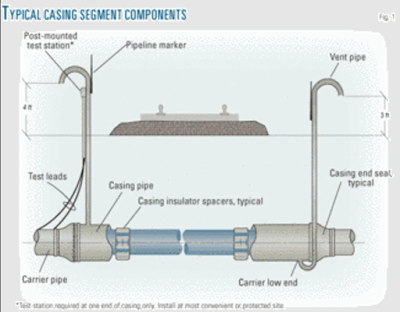 From: Oil & Gas Journal
From: Oil & Gas Journal That explains the J-shaped (or candycane shape, depending on your point-of-view) tubes. They're vent pipes that connect to a casing pipe that contains the actual petroleum pipe.
But to my surprise, it ALSO tells us what that yellow post next to the vent pipe is! It's a "post-mounted test station."
[ petroleum post-mounted test station ]
quickly leads us to determine that this triangular (cross-section) yellow post with a red cap is in fact a cathodic protection test station. (Remember that we discussed anode/cathode protection in an earlier SRS. The key idea is that metal objects, like pipes, that are underground create a current that causes corrosion. A test station lets the pipeline workers check to see if corrosion is happening in the pipe.)
But what's a casing pipe? Reading some of those pages taught me that where a pipe passes beneath a road or rail tracks, the pipe is enclosed within a larger diameter pipe that "encases" the smaller pipe. The vents are allow testing of the enclosed volume--to check if anything is leaking, or to provide a way to pump out any excess, OR to allow the workers to pump a fluid into the space to solve other issues.
Who knew? I didn't.
Since I was curious about the exact post-mounted test station, I wanted to see if I could find the manufacturer. Sure enough, the query:
[ pipeline triangular test station post ]
led me to a maker of such devices, Rhino Markers, which looks exactly like the post next to the casing vent pipe. In the above image.
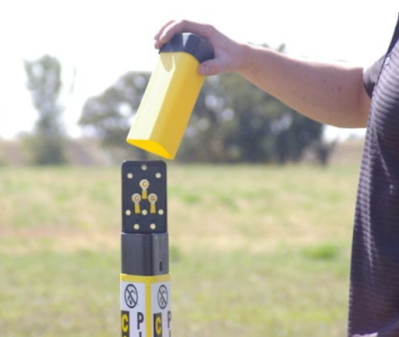 TriView+ test station with terminals for testing points.
TriView+ test station with terminals for testing points.3. Finally, this is a common thing to see along roadsides in more rural parts of the state. What is that silver canister with the orange label? What does it do?
 Link
LinkI tried two different ways to do this.
First method: Search-By-Image didn't do much for me (I tried Google, Bing, and Yandex), I even tried cropping the image just to the silver canister. Nothing.
I then tried describing what I saw, doing lots of Image search variations of silver, can, pot, SLC, RPTR, 6A, FIL, F, cable, roadside, etc. Nothing worked.
But then I got lucky (after about 4 minutes) when I tried: [ pot rptr pole telephone ]
that's when I spotted this in the Image search results page:

Notice that image in the lower right corner? Here's the closeup:

That looks very very close to what we see in our Challenge photo above.
When you click through to the article, you'll see that Erik Torkells had this same question before I did, they called their local telephone operating company, Frontier. They told him that it's a "...repeater that extends Frontier’s network in more remote areas or where signal is weak."
My next query, slightly more focused with this new information:
[ telephone network repeater cylinder pole ]
gave me a hit at AnnsGarden.com pole collection:
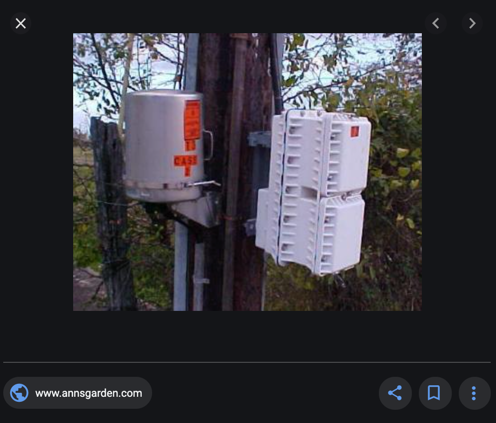
Interestingly, BELOW this hit are shown the Related Images: which turn out to be incredibly useful.

Looking through this collection of pages, it becomes very quickly clear that our silver "cooking pot" in the image is actually a container for a T1 repeater. The external canister is a stainless steel pressure vessel that can be pressurized to keep moisture out. (See the part specs for details.)
Method #2: I tried this out of sheer curiosity, and was surprised that it worked so well. I just used my cell phone, took a picture of my monitor and ran Lens over the image. To my immense surprise, it just worked, and immediately gave me a link to the above AnnsGarden site.

No, I don't know why Google Lens isn't available as part of Search-by-Image yet; I'm told it will be... someday.
Until then, we have to use our SRS skills where we find them!
Search Lessons
1. Inspect the image carefully. I often figure out what's in the image well after I've gone home. Being able to zoom in ("Enhance! Enhance!") and look at the details lets you ask questions that don't occur to you when you're on location. Corollary: Take more pictures from different angles than you think you might need. Storage is cheap, but traveling back to the location might be difficult.
2. You might have to explore variations on your query. I was surprised at how many queries it took me for both images 2 and 3. The first, and most obvious queries didn't work. But I took 10 (or 15, or 20) shots at it and eventually found that useful clue that got me to the answer. Be persistent! Not everything that's valuable can be found with a single query!
3. Try Google Lens... even when you don't think it will work! In this case, I tried Lens just by pointing my camera at the monitor.. yes, there are artifacts in the image, but Lens impressed me by returning great results--even under less than ideal conditions! Check it out!
Keep exploring... and...
Search On!
March 29, 2021
Pro tip: How to Search your tabs
You might have heard me mention...
.. that the ability to search-your-tabs is a key productivity Chrome extension. I've used a number of Chrome extensions over the years to get this capability. But here's a Pro Tip for power SearchResearchers.
NOW IT'S BUILT-IN TO CHROME!
Look for the icon in the upper right of your Chrome window The circle with the downward-pointing triangle:
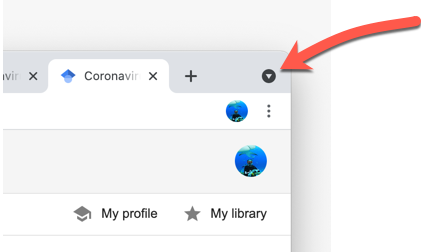
(If you don't see this, check out the note at the bottom. It will improve your life.)
When you click on that icon, you'll see a list of all your open tabs. It's scrollable, if you can't remember the tab title. BUT... You can then type in something to find the tab you need.
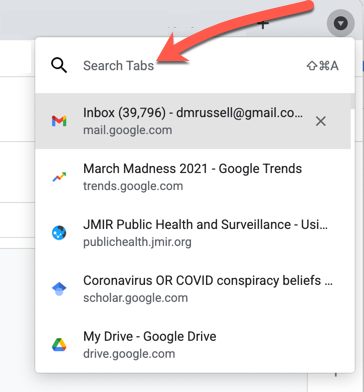
Enjoy!
Use the keyboard shortcut. (You saw that, right?)
Search on.... in your tabs!!
AND... if you don't see the icon in the upper right corner of your browser, do this:
1. In the Chrome URL bar, type (or click on this link):
chrome://flags/#enable-tab-search
2. Click enter.
3. You'll be taken to the Chrome Browser's Experimental Features menu and a highlighted box that says "Enable Tab Search."
4. Enable it.
5. Relaunch your browser.
March 26, 2021
Four tricks you need to know to read on Google Books
Google Books...

... you might have used it to do research. Even though it's a resource I use all the time, this week I learned a few tricks that completely change the way I use Google Books. Here are the 4 key things that you need to know:
1. Move forward/backward in a book with J and K.
I'm amazed that I didn't know this! Instead of trying to click the left arrow / right arrow with your mouse, just press the J key to move forward and the K key to move backwards. Simple, but it completely changes the way you read.

2. Select Full-view or Google eBooks to find books in Full-view
Of course, the "Free Google eBooks" that are in full-view are mostly older books, but that still might be useful. Here's a side-by-side comparison that shows Any vs. Free eBook vs. Any (with full-view only selected in the advanced search menu).
 Click to see in full-res.
Click to see in full-res.
3. When you want to search carefully, use the Advanced search menu for Books.
It's kind of hidden, but here's how to get to it.

Once you're there, you'll see a lot of options--check out the figure below. For today, just notice the view options below the blue area: All books, Limited preview, Full view only, Google eBooks--these are the different viewing conditions for the books.
 Yeah, it looks old-fashioned, but it works.
Yeah, it looks old-fashioned, but it works. 4. Use the 2-page viewer AND the multi-page viewer.
Somehow, I totally missed this in the Books user interface. Pay attention to these three buttons:
 Default view is 1-page. High res: great for reading.
Default view is 1-page. High res: great for reading. As you see here, the default view is 1-page. That's great for reading, but not so great for skimming.
And skimming is a great way to quickly get an overview of an entire book. If you're searching for a particular piece of information (say, in a graphic or illustration), the multi-page overview is your friend. Here's that previous book Adorning the World: Art of the Marquesas Islands in multi-page:
 A multi-page view of Adorning the World.
A multi-page view of Adorning the World. And lastly, I actually prefer the 2-page view because it often shows you how the two-page spread sits on the open book. In this example, the map makes a LOT more sense when seen in a 2-page layout:
 From: Theatrum orbis terrarum (1570)
From: Theatrum orbis terrarum (1570)Check these tools out. Trust me--they'll change the way you read Google Books online.
Search on!
March 24, 2021
SearchResearch Challenge (3/24/21): What ARE those things?
I constantly ask why, what, where, who, and how...
 Gratuitous curious internet cat image, although she's probably
Gratuitous curious internet cat image, although she's probably wondering why you haven't delivered her next meal yet...
... yes, that means I'm as curious as a cat, but if you read this blog, you're probably equally curious.
Today's Challenges are about those moments when you're wandering around and you spot something that you just don't understand. I my case, I usually take a photo and then SearchResearch it when I get home.
Here are three images I took recently that I had to think about. Can you figure these out as well? Perhaps you see things like this and wonder, curiously, what's going on. Let's figure these out together.
1. What's going on here? Or, more properly, what happened here? This seems a bit... unusual, no?
 Link
Link2. And what's this thing? This is from Southern California, and you see them everywhere... but I've always wondered what they're doing. What it this and what does it do? (They usually have the yellow warning post, but not always...)
 Link
Link3. Finally, this is a common thing to see along roadsides in more rural parts of the state. What is that silver canister with the orange label? What does it do?
 Link
Link
These are full, clickable images (if you want to download them at full resolution).
Let us know what you think they are--and, of course, HOW you figured it out!
We want to learn from the best of our SearchResearch practice.
Search on!



